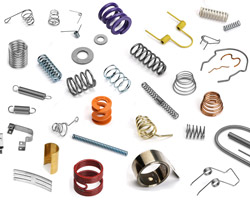
Posted to News on 22nd Jul 2015, 11:29
How to maximise spring life: 7 top tips
Lee Spring offers seven tips to help engineers maximise the life of the springs they are specifying.

Spring life is an important factor to consider when specifying springs because they are often vital components within an assembly. The following top tips are intended to help engineers specify springs that will give the required lifetime without premature failure.
1. Max your material choices
Material selection is key to good spring design. Consult with a Lee Spring engineer to determine whether upgrading to a higher tensile range or quality grade material can improve cycle life for a particular application.
Choosing the right material for a spring is key to a good, long-lasting performance. There are plenty of materials to choose from, including super alloys, which offer excellent mechanical strength, maintain their shape and structure in extreme temperatures and are non-corrosive for nuclear or offshore industries, or Nimonic alloys for use in high temperatures.
2. Stress kills
We all know how bad stress can be for us, but did you know that it is also the biggest threat to spring health too? Engineers can help springs to live longer by selecting a larger wire diameter or using a lower final load to reduce those unwanted high stress levels.
3. Keep cool
Spring relaxation - or a loss of spring load - occurs faster in high-temperature applications due to stress over time. Reducing operating temperatures can lessen the chances of spring relaxation.
4. Say no to shock loading
Shock loading is when the weight of a load is suddenly increased or sped up, such as when a load is dropped from a height. The speed with which a load is applied to a spring will increase the weight of the load, resulting in more damage to the spring - much like when you drop something small on your toe from great height; it hurts! Minimising this can save springs from coil clash, wear, non-axial forces and dynamic loading, which can all reduce the maximum potential and longevity of the spring.
5. Shot peen for strength
Shot peening is the process of cold working with a machine to dimple the surface of the spring, making it stronger and more resistant to that deadly stress mentioned earlier.
6. Reduce resonance
While achieving the right frequency usually sounds like a good thing, with springs it is not. When a spring's natural frequency matches that of the frequency of the operating speed, it will resonate, creating a low vibration that can cause the spring to break - like an opera singer breaking a glass by pitching an exact note! To avoid this, keep the operating frequency to no more than one-thirteenth of the spring's natural frequency.
7. Pre-stress for less stress
The act of pre-stressing can help springs to live that little bit longer. Pre-stressing is an additional manufacturing procedure that raises the elastic limit in torsion, allowing the use of higher solid stresses in the springs - so they will be stronger for longer, and far less stressed.
To find out more about how to get the most out of springs, get in touch with Lee Spring's experienced engineers, who can provide expert assistance and technical support.
For more information about Lee Spring products, to order a catalogue or to find out more about the Lee Spring custom design service, go to www.leespring.co.uk.






























